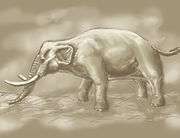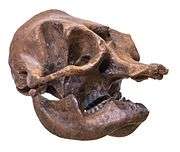Palaeoloxodon falconeri
| Palaeoloxodon falconeri Temporal range: Late Pleistocene to Holocene | |
|---|---|
.jpg) | |
| Mounted skeleton, Nebraska State Museum of Natural History | |
| Scientific classification | |
| Kingdom: | Animalia |
| Phylum: | Chordata |
| Class: | Mammalia |
| Order: | Proboscidea |
| Family: | Elephantidae |
| Genus: | Palaeoloxodon |
| Species: | P. falconeri |
| Binomial name | |
| Palaeoloxodon falconeri Busk, 1867 | |
| Synonyms | |
|
Elephas falconeri Busk, 1867 | |
Palaeoloxodon falconeri (formerly Elephas falconeri, or more commonly as the Pygmy elephant) is an extinct Siculo-Maltese species of elephant that has derived from the Straight-tusked elephant.[1]
Taxonomy

In 1867, George Busk had proposed the species Elephas falconeri for many of the smallest molars selected from the material originally ascribed by Hugh Falconer to Palaeoloxodon melitensis.[2][1]
Description
This island-bound elephant was an example of insular dwarfism, with an adult male specimen MPUR/V n1 measured 96.5 cm (3 ft 2.0 in) in shoulder height and weighed about 305 kg (672 lb), and an adult female specimen MPUR/V n2 measured 80 cm (2 ft 7.5 in) in shoulder height and weighed about 168 kg (370 lb).[3] P. falconeri's ancestors most likely reached the Mediterranean islands during a period of Pleistocene maximum when the sea levels were around 100 m (328 ft) lower, that significantly reduced distances and opened land bridges in between islands and from and to the mainland.[lower-alpha 1]
Cultural significance
The belief in Cyclopes may have originated in P. falconeri skulls found in Sicily.[5] As early as the 14th century, scholars had noted that the nasal cavity could be mistaken for a singular giant eye socket.[6]
Gallery
|
See also
Notes
References
- 1 2 Palombo, M.R. (2001). Endemic elephants of the Mediterranean Islands: knowledge, problems and perspectives. The World of Elephants, Proceedings of the 1st International Congress (October 16–20, 2001, Rome): 486–491.
- ↑ Busk, G. (1867). Description of the remains of three extinct species of elephant, collected by Capt. Spratt, C.B.R.N., in the ossiferous cavern of Zebbug, in the island of Malta. Transactions of the Zoological Society of London, 6: 227–306.
- ↑ "Body Size, Biology and Encephalization Quotient of Palaeoloxodon ex gr. P. falconeri from Spinagallo Cave (Hyblean plateau, Sicily)"
- ↑ "GLOBE: A Gallery of High Resolution Images". National Geophysical Data Center (NGDC). NOAA. Retrieved 17 June 2014.
- ↑ "Cyclops". Greek and Roman Mythology. (Mobile). Boston: MobileReference.com. 2007. ISBN 9781605010915.
- ↑ "Greek Giants". American Museum of Natural History. Retrieved 15 June 2014.

